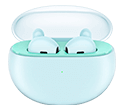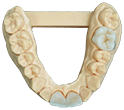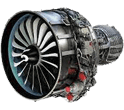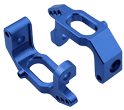
5-axes needed for Tool Grinding...
The "A" axis is used to access the cutter around its circumference. The "B" axis is needed for cutters such as ball mills that are not just cylindrical the whole length of the tool. 5-Axis machines may be characterized as "continuous" (also called "simultaneous") or "positional" (sometimes called "indexing"). A 5-axis continuous machine is capable of cutting while all 5 axes move. This allows continuous machining over complex shapes, and is more powerful than 5-axis positional. A positional machine can only cut in 3 axes at a time, but it can position before cutting using all 5 axes. The positional approach is much simpler to implement, both for software and hardware, and so may be found in older or lower end machines. 5-axis positional or indexed is also sometimes called 3+2 axis. In theory, you can cut any part with 5-axis positional that you could cut with 5-axis continuous. A machine designed for continuous should be faster. In addition, 5-axis positional may introduce dwells (See also dwell) that result in visible marks in the surface finish.
The ABEC system relates to other bearing precision rating systems as follows:
|
ABEC SYSTEM |
|
ISO SYSTEM |
|
DIN SYSTEM |
|
ABEC 1 |
|
|
|
P0 |
|
ABEC 3 |
|
Class 6 |
|
P6 |
|
ABEC 5 |
|
Class 5 |
|
P5 |
|
ABEC 7 |
|
Class 4 |
|
P4 |
|
ABEC 9 |
|
Class 2 |
|
P2 |
The best place to learn more about angular contact bearings is from the manufacturer's bearing catalogs:
Barden Timken NSK FAG

Mill Axes
Lathe Axes
On a 4-axis or 5-axis mill there are additional rotational axes. Here is an example of a 5-axis mill with trunion table:
A 4-Axis Mill simply omits the B-Axis.

CAD Drawing of a Bench Tapper Made in Rhino 3D...
- Number of flutes. Endmills may be had in a variety of configurations including 2, 3, 4, or more flutes.
- Roughing or Finish Style: Roughing endmills are good for hogging out material, but not so great for finishing.
- Centercutting: Determines whether the endmills center cuts. If not, the mill cannot be used to plunge cut. See Also Centercutting.
- Material: Endmills are made from a variety of materials ranging from High Speed Steel to Solid Carbide.
- Coating: There are a variety of coatings designed to improve the performance of the endmill.
- Type: Standard, ball nose, double ended, etc.
- Length: Shorter endmills are more rigid (See also Rigidity), longer endmills may be needed to reach.
- Diameter

Roughing Endmill in an R8 Shank Millholder...

Notice that when fed 0.5" the actual chip thickness of the 45 degree cutter is only 0.35", hence the higher feedrates...
- Dovetail Ways: Very common on mills, dovetail ways look like the dovetails used in wood joinery.
- Box Ways: Box Ways are rectangular cross section, as opposed to the angular shape of dovetail ways. Box ways are very strong, but they suffer from two shortcomings. First, they involve a lot of surface contact area, so managing friction is key. Second, in order to slide at all, some clearance is required, which results in some slop in their travel. They are the strongest and most rigid design, but they are difficult and expensive to manufacture.
- Prismatic Ways: These are prism shaped ways common to lathes.
- Linear Ways: Linear ways use linear slides as rails and so are much different than the other three styles. The roll on ball bearings as opposed to having more metal-to-metal contact in the other designs. Linear ways will have the least rigidity, but for the price, they are ideal for precision and high speeds.

- Dovetail Ways: Very common on mills, dovetail ways look like the dovetails used in wood joinery.
- Box Ways: Box Ways are rectangular cross section, as opposed to the angular shape of dovetail ways. Box ways are very strong, but they suffer from two shortcomings. First, they involve a lot of surface contact area, so managing friction is key. Second, in order to slide at all, some clearance is required, which results in some slop in their travel. They are the strongest and most rigid design, but they are difficult and expensive to manufacture.
- Prismatic Ways : These are prism shaped ways common to lathes.
- Linear Ways : Linear ways use linear slides as rails and so are much different than the other three styles. The roll on ball bearings as opposed to having more metal-to-metal contact in the other designs. Linear ways will have the least rigidity, but for the price, they are ideal for precision and high speeds.

Box Ways vs Dovetail Ways...





















